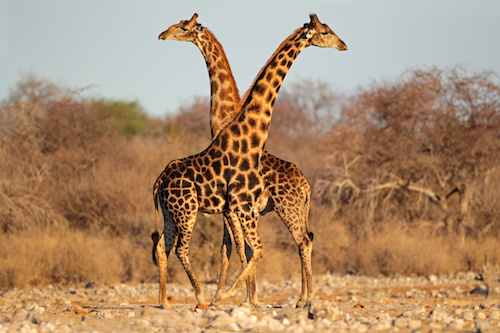 Evolution
Evolution
 Intelligent Design
Intelligent Design
How the Giraffe Got Its Looooong Neck

From New Scientist (“Giraffes got their long necks thanks to a few dozen gene changes“):
Tweaking a few dozen key genes that regulate development gave giraffes their long necks. It’s a discovery that points to the subtle complexity behind this striking adaptation.
Biologists now routinely compare genomes of related species to identify the genes that may underpin their differences. Douglas Cavener of Penn State University in University Park, Pennsylvania, realised that giraffes afforded an unusual opportunity because their closest relative, the okapi, lacks the giraffe’s elongated body.
Cavener and his team sequenced the genomes of both species and identified 70 genes where the giraffe version showed clusters of unique changes or other signs of natural selection.
When the researchers looked more closely, they found that 46 of these genes were involved in regulating the development of the skeleton, cardiovascular system or nervous system. This fits giraffes’ unusual biology: long necks and legs require unusual bone growth, and their great height requires specialised changes in the heart, blood vessels and nerves.
“That was really remarkable,” says Cavener. Similar studies of unique genetic changes in other mammals typically turn up no more than one or two developmental genes, he notes.
The original paper in Nature Communications reporting this research is open access. It is indeed remarkably interesting, and fits very well with my nonrandom evolutionary hypothesis.
In the sequencing of the genes of the giraffe and the okapi, 70 genes were found that differed between the two species. Interestingly, these genes encode well-known regulators of skeletal, cardiovascular, and neural development, and are likely to be contributors to the giraffe’s unique characteristics.
These differences had to evolve together and quickly to permit the newly evolved giraffe to survive. This evolution would be impossible by random variations and natural selection. It is much more likely to have occurred, as I have described in my book The Evolution Revolution, by way of nonrandom genetic rearrangements that are stimulated by environmental stress.
Transposable elements stimulated by environmental stress are known to turn genes on or off and are known even to form entirely new genes. These genetic changes are often adaptive to the new environment. Organisms have an endogenous capability of adapting to new environments in this way.
Image credit: © EcoView — stock.adobe.com.
